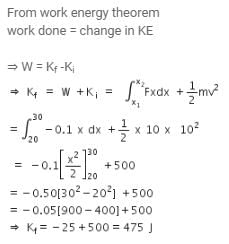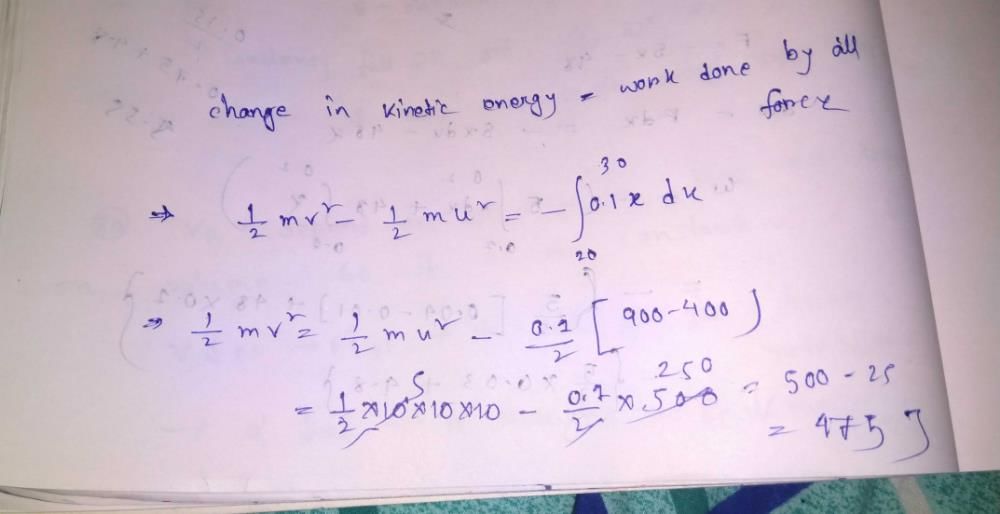NEET Exam > NEET Questions > A block of mass 10 kg is moving in x-directio...
Start Learning for Free
A block of mass 10 kg is moving in x-direction with a constant velocity of 10 m−s⁻1. It is subjected to a retarding force F = 0.1x J-m⁻1 during its travel from x = 20 m to x = 30 m. Its final kinetic energy will be
- a)475 J
- b)450 J
- c)275 J
- d)250 J
Correct answer is option 'A'. Can you explain this answer?
| FREE This question is part of | Download PDF Attempt this Test |
Verified Answer
A block of mass 10 kg is moving in x-direction with a constant velocit...

Most Upvoted Answer
A block of mass 10 kg is moving in x-direction with a constant velocit...
/s. If a force of 30 N is applied in the opposite direction of motion, what will be the new velocity of the block?
We can use the formula:
F = ma
where F is the force, m is the mass, and a is the acceleration.
Since the block is already moving with a constant velocity, we know that there is no net force acting on it. This means that the force of friction is equal and opposite to the applied force. So, we can write:
30 N - F_friction = 0
where F_friction is the force of friction.
Solving for F_friction, we get:
F_friction = 30 N
Now, we can use the formula:
F_friction = μ * N
where μ is the coefficient of friction and N is the normal force.
Since the block is moving horizontally, the normal force is equal to the weight of the block, which is:
N = m * g
where g is the acceleration due to gravity, which is approximately 9.8 m/s^2.
So, we can write:
F_friction = μ * m * g
30 N = μ * 10 kg * 9.8 m/s^2
Solving for μ, we get:
μ = 0.306
Now, we can use the formula:
F = ma
where F is the net force, m is the mass, and a is the acceleration.
The net force is:
F = 30 N - F_friction
F = 30 N - μ * m * g
F = 30 N - 3 N
F = 27 N
The acceleration is:
a = F / m
a = 27 N / 10 kg
a = 2.7 m/s^2
The new velocity can be found using the formula:
v = v0 + at
where v0 is the initial velocity (10 m/s), a is the acceleration (-2.7 m/s^2), and t is the time taken.
Since the block is moving with a constant velocity, we know that the time taken for the force to change the velocity is zero. Therefore, the new velocity will be:
v = 10 m/s + 0
v = 10 m/s
So, the new velocity of the block is still 10 m/s, but the force of friction has increased to balance the applied force.
We can use the formula:
F = ma
where F is the force, m is the mass, and a is the acceleration.
Since the block is already moving with a constant velocity, we know that there is no net force acting on it. This means that the force of friction is equal and opposite to the applied force. So, we can write:
30 N - F_friction = 0
where F_friction is the force of friction.
Solving for F_friction, we get:
F_friction = 30 N
Now, we can use the formula:
F_friction = μ * N
where μ is the coefficient of friction and N is the normal force.
Since the block is moving horizontally, the normal force is equal to the weight of the block, which is:
N = m * g
where g is the acceleration due to gravity, which is approximately 9.8 m/s^2.
So, we can write:
F_friction = μ * m * g
30 N = μ * 10 kg * 9.8 m/s^2
Solving for μ, we get:
μ = 0.306
Now, we can use the formula:
F = ma
where F is the net force, m is the mass, and a is the acceleration.
The net force is:
F = 30 N - F_friction
F = 30 N - μ * m * g
F = 30 N - 3 N
F = 27 N
The acceleration is:
a = F / m
a = 27 N / 10 kg
a = 2.7 m/s^2
The new velocity can be found using the formula:
v = v0 + at
where v0 is the initial velocity (10 m/s), a is the acceleration (-2.7 m/s^2), and t is the time taken.
Since the block is moving with a constant velocity, we know that the time taken for the force to change the velocity is zero. Therefore, the new velocity will be:
v = 10 m/s + 0
v = 10 m/s
So, the new velocity of the block is still 10 m/s, but the force of friction has increased to balance the applied force.
Free Test
FREE
| Start Free Test |
Community Answer
A block of mass 10 kg is moving in x-direction with a constant velocit...

Attention NEET Students!
To make sure you are not studying endlessly, EduRev has designed NEET study material, with Structured Courses, Videos, & Test Series. Plus get personalized analysis, doubt solving and improvement plans to achieve a great score in NEET.

|
Explore Courses for NEET exam
|

|
Similar NEET Doubts
A block of mass 10 kg is moving in x-direction with a constant velocity of 10 m−s⁻1. It is subjected to a retarding force F = 0.1x J-m⁻1 during its travel from x = 20 m to x = 30 m. Its final kinetic energy will bea)475 Jb)450 Jc)275 Jd)250 JCorrect answer is option 'A'. Can you explain this answer?
Question Description
A block of mass 10 kg is moving in x-direction with a constant velocity of 10 m−s⁻1. It is subjected to a retarding force F = 0.1x J-m⁻1 during its travel from x = 20 m to x = 30 m. Its final kinetic energy will bea)475 Jb)450 Jc)275 Jd)250 JCorrect answer is option 'A'. Can you explain this answer? for NEET 2024 is part of NEET preparation. The Question and answers have been prepared according to the NEET exam syllabus. Information about A block of mass 10 kg is moving in x-direction with a constant velocity of 10 m−s⁻1. It is subjected to a retarding force F = 0.1x J-m⁻1 during its travel from x = 20 m to x = 30 m. Its final kinetic energy will bea)475 Jb)450 Jc)275 Jd)250 JCorrect answer is option 'A'. Can you explain this answer? covers all topics & solutions for NEET 2024 Exam. Find important definitions, questions, meanings, examples, exercises and tests below for A block of mass 10 kg is moving in x-direction with a constant velocity of 10 m−s⁻1. It is subjected to a retarding force F = 0.1x J-m⁻1 during its travel from x = 20 m to x = 30 m. Its final kinetic energy will bea)475 Jb)450 Jc)275 Jd)250 JCorrect answer is option 'A'. Can you explain this answer?.
A block of mass 10 kg is moving in x-direction with a constant velocity of 10 m−s⁻1. It is subjected to a retarding force F = 0.1x J-m⁻1 during its travel from x = 20 m to x = 30 m. Its final kinetic energy will bea)475 Jb)450 Jc)275 Jd)250 JCorrect answer is option 'A'. Can you explain this answer? for NEET 2024 is part of NEET preparation. The Question and answers have been prepared according to the NEET exam syllabus. Information about A block of mass 10 kg is moving in x-direction with a constant velocity of 10 m−s⁻1. It is subjected to a retarding force F = 0.1x J-m⁻1 during its travel from x = 20 m to x = 30 m. Its final kinetic energy will bea)475 Jb)450 Jc)275 Jd)250 JCorrect answer is option 'A'. Can you explain this answer? covers all topics & solutions for NEET 2024 Exam. Find important definitions, questions, meanings, examples, exercises and tests below for A block of mass 10 kg is moving in x-direction with a constant velocity of 10 m−s⁻1. It is subjected to a retarding force F = 0.1x J-m⁻1 during its travel from x = 20 m to x = 30 m. Its final kinetic energy will bea)475 Jb)450 Jc)275 Jd)250 JCorrect answer is option 'A'. Can you explain this answer?.
Solutions for A block of mass 10 kg is moving in x-direction with a constant velocity of 10 m−s⁻1. It is subjected to a retarding force F = 0.1x J-m⁻1 during its travel from x = 20 m to x = 30 m. Its final kinetic energy will bea)475 Jb)450 Jc)275 Jd)250 JCorrect answer is option 'A'. Can you explain this answer? in English & in Hindi are available as part of our courses for NEET.
Download more important topics, notes, lectures and mock test series for NEET Exam by signing up for free.
Here you can find the meaning of A block of mass 10 kg is moving in x-direction with a constant velocity of 10 m−s⁻1. It is subjected to a retarding force F = 0.1x J-m⁻1 during its travel from x = 20 m to x = 30 m. Its final kinetic energy will bea)475 Jb)450 Jc)275 Jd)250 JCorrect answer is option 'A'. Can you explain this answer? defined & explained in the simplest way possible. Besides giving the explanation of
A block of mass 10 kg is moving in x-direction with a constant velocity of 10 m−s⁻1. It is subjected to a retarding force F = 0.1x J-m⁻1 during its travel from x = 20 m to x = 30 m. Its final kinetic energy will bea)475 Jb)450 Jc)275 Jd)250 JCorrect answer is option 'A'. Can you explain this answer?, a detailed solution for A block of mass 10 kg is moving in x-direction with a constant velocity of 10 m−s⁻1. It is subjected to a retarding force F = 0.1x J-m⁻1 during its travel from x = 20 m to x = 30 m. Its final kinetic energy will bea)475 Jb)450 Jc)275 Jd)250 JCorrect answer is option 'A'. Can you explain this answer? has been provided alongside types of A block of mass 10 kg is moving in x-direction with a constant velocity of 10 m−s⁻1. It is subjected to a retarding force F = 0.1x J-m⁻1 during its travel from x = 20 m to x = 30 m. Its final kinetic energy will bea)475 Jb)450 Jc)275 Jd)250 JCorrect answer is option 'A'. Can you explain this answer? theory, EduRev gives you an
ample number of questions to practice A block of mass 10 kg is moving in x-direction with a constant velocity of 10 m−s⁻1. It is subjected to a retarding force F = 0.1x J-m⁻1 during its travel from x = 20 m to x = 30 m. Its final kinetic energy will bea)475 Jb)450 Jc)275 Jd)250 JCorrect answer is option 'A'. Can you explain this answer? tests, examples and also practice NEET tests.

|
Explore Courses for NEET exam
|

|
Suggested Free Tests
Signup for Free!
Signup to see your scores go up within 7 days! Learn & Practice with 1000+ FREE Notes, Videos & Tests.
























